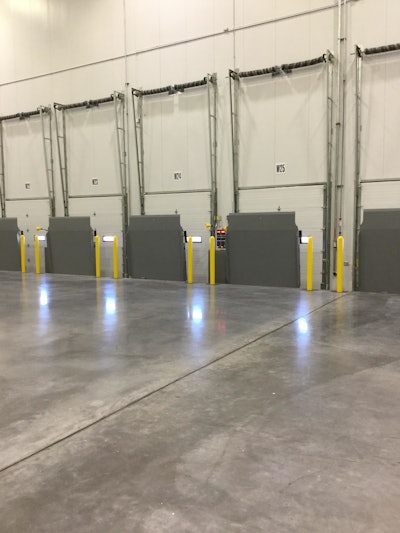
It’s a statistic often quoted among those in the food industry – 48 million people in the United States get sick from food and beverages each year, and 128,000 of them end up hospitalized (CDC). Most of us know these figures and that much of this is preventable with appropriate food safety measures.
Given the requirements of the Food Safety Modernization Act of 2011 (FSMA) and a collective responsibility to ensure the safety of products, it’s important to utilize the right food equipment in the right ways. But, how does this mandate translate to your facilities’ loading docks and cold storage systems? What questions should you be asking to ensure you’re in proper compliance with FSMA and other food safety standards?
Here’s a quick outline of the Top 3 questions to think about.
1. Is your dock design FSMA-friendly?
When it comes to complying with the FSMA and ensuring the safety of your food products, you may never have considered the potential threats and risks in the design and setup of your loading dock. While this area of a commercial building is often neglected, it actually plays a critical role in maintaining a safe temperature and environment for food in transit. Many companies still load to and from their trucks and trailers through a faulty loading dock design that leaves room for warm and contaminated air to reach the food products. The most common issue we see in dock design allows space between the truck or trailer doors and the opening of the loading dock. Even the narrowest space can cause a major problem when it comes to food temperature and contamination. That’s why we always recommend a drive-through loading dock application that allows the doors of a trailer to open into the building, maintaining the integrity of the load for security, contamination control and temperature safety. When there’s no extra space for air escape between your cold trailer and your building, you’re better able to comply with the FSMA and ensure food safety.
2. When did you last check the integrity of your dock seal?
Another important question to ask about your dock and door safety is whether you’ve recently verified the integrity of the dock seal. Even when employees are as efficient and expeditious as possible with the unloading of food products, a defect in dock equipment can pose a serious threat to food safety. Dock seals that allow warm air to infiltrate cold storage can quickly contaminate food and risk the health of end consumers, but they can also work against the refrigerator system, making it use more energy and run up a higher utility bill. A broken or defective dock seal can also allow other forms of contaminants into the food environment, including dust, pests and more. The solution for a less than stellar dock seal is usually either an upgraded dock leveler, a vehicle restraint or both. Dock levelers seal off the loading zone from the elements, and vertically stored levelers offer more protection than older models as they lie along the same plane as the floor. This eliminates the likelihood that air and contaminants can get in when inventory arrives or departs. A vehicle restraint is another great option for enhancing the integrity of your dock seal – they prevent trailers from rolling away from the dock, which reduces the chances of a broken dock seal, but also makes it less likely that a forklift accident will happen.
3. Have you chosen the right cold storage doors?
Finally, it’s important to take a careful look at your current cold storage doors. This is the simplest and most fundamental aspect of your cold storage chain and temperature control operations. Cooler and freezer doors, especially their seals, must be working every day to keep food products safe and energy costs down. The ideal cold storage doors minimize the escape of cold air, ensuring that all food products stay at the right temperature without overtaxing the refrigeration system. Efficient and effective doors typically either slide or fold, and whichever form they take – they function well on a very consistent basis. Facility owners who neglect to install and maintain high-quality doors may find it difficult to maintain cold temperatures and energy efficiency, putting their customers and bottom line at risk. When choosing the right cold storage doors, it’s important to consider the day-to-day logistical operations function around the doors. If there is heavy use of forklifts and other large, mobile equipment, impact resistance may be your most important feature to consider. In other cases, it may be that visibility into the cooler or freezer is critical and a door that offers a transparent window may be your best bet. Sliding doors use variable speed motors to open and close, and usually come in multiple sizes. All are made from insulated closed-cell foam panels and do not require a panel defrost system. Folding doors, which open on a roller and track assembly, offer full visibility and impact resistance simultaneously and usually come with three defrost systems to ensure frost buildup doesn’t harm performance. It’s important to explore the range of options available when it comes to cold storage doors, ensure you’ve selected the right model for your facility, and perhaps most importantly, verify regularly that the doors are functioning and sealing appropriately.
For many food industry leaders and experts, the upkeep of the end-to-end cold chain has become more than a legal requirement. The maintenance of safe, cold food temperatures is now widely viewed as an important aspect of corporate social responsibility – reflecting positive commitments to customers and communities. We all share that responsibility and must act to ensure we’re doing what’s right for our consumers and neighbors.






![Adobe Stock 280800711 [converted]](https://img.foodlogistics.com/files/base/acbm/fl/image/2021/08/AdobeStock_280800711__Converted_.611e898daa123.png?auto=format%2Ccompress&fit=crop&h=167&q=70&rect=0%2C53%2C900%2C507&w=250)











